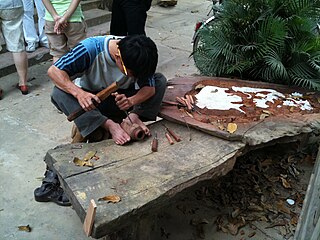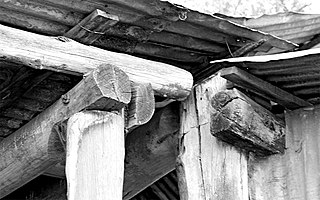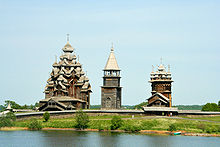
Woodworking is the skill of making items from wood, and includes cabinetry, furniture making, wood carving, joinery, carpentry, and woodturning.

Lumber is wood that has been processed into uniform and useful sizes, including beams and planks or boards. Lumber is mainly used for construction framing, as well as finishing. Lumber has many uses beyond home building. Lumber is referred to as timber in the United Kingdom, Europe, Australia, and New Zealand, while in other parts of the world the term timber refers specifically to unprocessed wood fiber, such as cut logs or standing trees that have yet to be cut.

Joinery is a part of woodworking that involves joining pieces of wood, engineered lumber, or synthetic substitutes, to produce more complex items. Some woodworking joints employ mechanical fasteners, bindings, or adhesives, while others use only wood elements.
A journeyman is a worker, skilled in a given building trade or craft, who has successfully completed an official apprenticeship qualification. Journeymen are considered competent and authorized to work in that field as a fully qualified employee. They earn their license by education, supervised experience and examination. Although journeymen have completed a trade certificate and are allowed to work as employees, they may not yet work as self-employed master craftsmen.

A tradesperson or tradesman/woman is a skilled worker that specialises in a particular trade. Tradespeople (tradesmen/women) usually gain their skills through work experience, on-the-job training, an apprenticeship programme or formal technical education.

Framing, in construction, is the fitting together of pieces to give a structure support and shape. Framing materials are usually wood, engineered wood, or structural steel. The alternative to framed construction is generally called mass wall construction, where horizontal layers of stacked materials such as log building, masonry, rammed earth, adobe, etc. are used without framing.

Japanese carpentry was developed more than a millennium ago that is known for its ability to create everything from temples to houses to tea houses to furniture by wood with the use of few nails.

A butt joint is a wood joint in which the end of a piece of material is simply placed against another piece. The butt joint is the simplest joint. An unreinforced butt joint is also the weakest joint, as it provides a limited surface area for gluing and lacks any mechanical interlocking to resist external forces.

André Jacob Roubo (1739–1791) was a French carpenter, cabinetmaker and author. Roubo was born and died in Paris, and was the son and grandson of master cabinetmakers. Roubo wrote several highly influential books on woodworking, an achievement which was especially notable given his relatively poor background and self-taught methods.
This glossary of woodworking lists a number of specialized terms and concepts used in woodworking, carpentry, and related disciplines.
Traditional trades is a loosely defined categorization of building trades who actively practice their craft in respect of historic preservation, heritage conservation, or the conserving and maintenance of the existing built environment. Though traditional trade practitioners may at times be involved in new construction, the emphasis of the categorization is toward work on existing structures, regardless of their age or their historic value, with a specific interest in replication or conservation of the original results and craft techniques.

Kim Bồng woodworking village is a village located in Cẩm Kim commune, Hội An, Quảng Nam Province, most notable for its carpentry and traditional woodworking products. Established in the 15th century, it reached its peak in the 18th century, during which time village craftsmen contributed their skills in woodworking to many different projects, including the imperial capital in Huế. Using their shipbuilding skills, they supplied ships and ghe bầu for the activities of the busy commercial port of Hội An.

The Shaker Shed is an exhibit building at Shelburne Museum in Shelburne, Vermont. It exhibits the museum's collection of hand-tools and household equipment.

Bush carpentry is an expression used in Australia and New Zealand that refers to improvised methods of building or repair, using available materials and an ad hoc design, usually in a pioneering or rural context.

The Timber Framers Guild is a non-profit, international, membership organization established in 1984 in the United States to improve the quality and education of people practicing the millennia-old art of Timber framing buildings and other structures with beams joined with primarily wooden joints. Today the stated goals of the Guild are to provide "... national and regional conferences, sponsoring projects and workshops, and publishing a monthly newsletter, Scantlings, and a quarterly journal, Timber Framing " In 2019, the Guild purchased the Heartwood School, which had been established in 1978 to teach skills and knowledge required for building energy-efficient homes and now focuses on timber framing, serving beginning to advanced students.

American historic carpentry is the historic methods with which wooden buildings were built in what is now the United States since European settlement. A number of methods were used to form the wooden walls and the types of structural carpentry are often defined by the wall, floor, and roof construction such as log, timber framed, balloon framed, or stacked plank. Some types of historic houses are called plank houses but plank house has several meanings which are discussed below. Roofs were almost always framed with wood, sometimes with timber roof trusses. Stone and brick buildings also have some wood framing for floors, interior walls and roofs.

City of Oxford College is a further education college in Oxford, England. It has two campuses: the City Centre campus in Oxford city centre, and the Technology Campus in Blackbird Leys, south-east of Oxford city.
cadwork informatik CI AG is a multinational software company headquartered in Basel, Switzerland. It develops and markets software products primarily for the construction industry. These products include timber industry products in computer-aided design (CAD) and computer-aided manufacturing (CAM) as well as products in building information model (BIM) and virtual design and construction (VDC). These products are suitable for designers, structural engineers, construction engineers, civil engineering draftspeople, building contractors, and in the case of BIMTeam VDC, the construction crews.






















